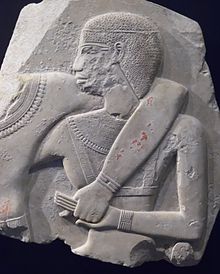Kemsit

| ||||
| Kemsit in hieroglyphs | ||||
|---|---|---|---|---|
| Era: Middle Kingdom (2055–1650 BC) | ||||
Kemsit was an ancient Egyptian queen consort, the wife of pharaoh Mentuhotep II of the 11th Dynasty. Her tomb (TT308) and small decorated chapel were found in her husband's Deir el-Bahari temple complex,[1] behind the main building, along with the tombs of five other ladies, Ashayet, Henhenet, Kawit, Sadeh and Mayet. Most of them were priestesses of Hathor, so it is possible that they were buried there as part of the goddess's cult, but it is also possible that they were the daughters of nobles the king wanted to keep an eye upon.
Only parts of her sarcophagus have been found, these are now in the Egyptian Museum in Cairo.[2]
The queen was also depicted on reliefs in the funerary temple of her husband Mentuhotep II. These depictions are today heavily destroyed, but it seems that she appeared in a scene showing a row of royal women. On the preserved fragments she is shown behind queen Kawit. Her title in the depiction is King's Beloved Wife.[3]

Kemsit may have been of Nubian origin, as indicated by depictions that show her face as black or dark pink.[4]
Her titles were: King's Beloved Wife (ḥmt-nỉswt mrỉỉ.t=f ), King's Ornament (ẖkr.t-nỉswt), King's Sole Ornament (ẖkr.t-nỉswt wˁtỉ.t), Priestess of Hathor (ḥm.t-nṯr ḥwt-ḥrw).[5]
Sources
[edit]- ^ Dodson, Aidan, Hilton, Dyan. The Complete Royal Families of Ancient Egypt. Thames & Hudson. ISBN 0-500-05128-3 (2004), p.89
- ^ Grajetzki, Wolfram. Ancient Egyptian Queens: A Hieroglyphic Dictionary. London: Golden House Publications. ISBN 0-9547218-9-6 (2005), p.30
- ^ Dieter Arnold: Relief of Wives of Nebhepetre Mentuhotep II, in: A. Oppenheim, d. Arnold, D. Arnold, Kei Yamamoto (editors): Ancient Egypt Transformed, The Middle Kingdom, New York 2015 ISBN 978-1-58839-564-1, 102-103, no. 43; the fragments are now in Geneva, Musėesd'Arte ed d'Histore, Gift of the Egypt Exploration Fund 1907 (4767)
- ^ Fisher, Marjorie M. (2012). "The History of Nubia". In Fisher, Marjorie M.; Lacovara, Peter; Ikram, Salima; D'Auria, Sue (eds.). Ancient Nubia: African Kingdoms on the Nile. Cairo: The American University in Cairo Press. p. 20. ISBN 978-977-416-478-1.
- ^ Grajetzki, op.cit., p.29
| |||||||||||||||||||||||||
| |||||||||||||||||||||||||
| |||||||||||||||||||||||||
| |||||||||||||||||||||||||
Text is available under the CC BY-SA 4.0 license; additional terms may apply.
Images, videos and audio are available under their respective licenses.
